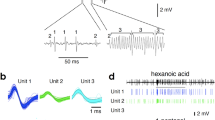Abstract
THE antennules of Squilla mantis have been shown by Schaller1 to be principal organs in food capture. They are 4–6 cm long in the adult animals and consist of three segments, the terminal segment bearing at its distal end three long lash-like extensions which are themselves repeatedly segmented. The first three segments of the antennules have relatively few sensory hairs along their lengths but there are numerous fine hairs on the terminal lashes2. The basal joint of the antennule allows the whole appendage to move in any direction, but the joints between the first and second, and the second and third, proximal segments allow movement in only one plane, that is lateral outward flexion from the extended position. The animals normally hold the antennules extended laterally but will point them forwards at objects brought into their visual field1.
This is a preview of subscription content, access via your institution
Access options
Subscribe to this journal
Receive 51 print issues and online access
$199.00 per year
only $3.90 per issue
Buy this article
- Purchase on Springer Link
- Instant access to full article PDF
Prices may be subject to local taxes which are calculated during checkout
Similar content being viewed by others
References
Schaller, E. F., Tierpsychol., 10, 1 (1953).
Giesbrecht, W., Fauna und Flora Golf Neapel, Monogr. 33 (1910).
Whitear, M., Phil. Trans. Roy. Soc., B, 245, 291 (1962).
Author information
Authors and Affiliations
Rights and permissions
About this article
Cite this article
SANDEMAN, D. Proprioceptor Organs in the Antennules of Squilla mantis. Nature 201, 402–403 (1964). https://doi.org/10.1038/201402a0
Issue Date:
DOI: https://doi.org/10.1038/201402a0
This article is cited by
-
Gaze stabilization in mantis shrimp in response to angled stimuli
Journal of Comparative Physiology A (2019)
-
Proprioceptors of the thoracic limbs of Squilla mantis (Crustacea, Stomatopoda)
Zoomorphology (1987)
-
Anatomy and physiology of proprioceptors in the cirri ofBalanus hameri
Journal of Comparative Physiology ? A (1978)
-
Innervation of the receptors present at the various joints of the pereiopods and third maxilliped of Homarus gammarus (L.) and other macruran decapods (crustacea)
Zeitschrift f�r Vergleichende Physiologie (1970)
Comments
By submitting a comment you agree to abide by our Terms and Community Guidelines. If you find something abusive or that does not comply with our terms or guidelines please flag it as inappropriate.



